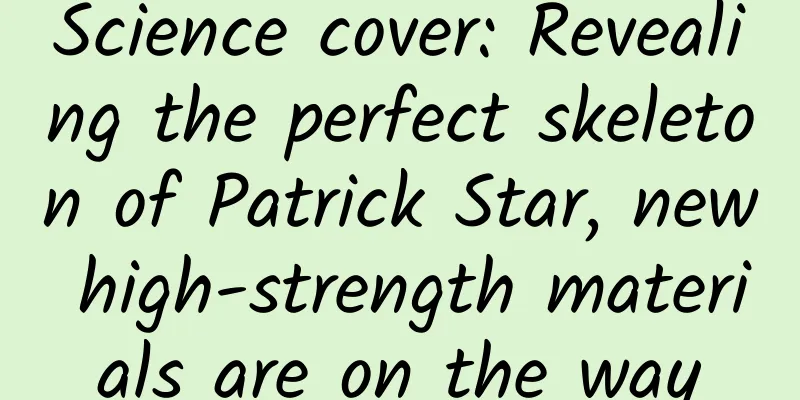Science cover: Revealing the perfect skeleton of Patrick Star, new high-strength materials are on the way

|
Written by: Zhu Hengheng Editor: Wang Haha Layout: Li Xuewei For the industrial field, especially the automotive and aerospace manufacturing industries, it is very necessary to find lightweight and strong materials. These new materials can improve energy efficiency while ensuring strength. However, in long-term industrial practice, the research and development of lightweight and high-strength materials is extremely slow. After all, stronger materials are often denser and heavier. Recently, a research team led by Dr. Ling Li, an assistant professor in the School of Mechanical Engineering at Virginia Tech, has pointed out the direction for the development of new lightweight and high-strength ceramic composites. Dr. Ling Li's research team studied samples of multi-sectioned starfish skeletons widely distributed in the Indo-Pacific region and found for the first time that the skeletons of starfish are composed of a single microcrystalline structure that is very uniform and can be described by mathematical formulas. It is composed of branches connected by nodes, similar to the structure of the Eiffel Tower. More interestingly, they also found that the uniformity of the microcrystalline structure is essentially a single crystal structure at the atomic level. Dr. Li said, "This unique material is like a lattice carved from a single crystal of calcite. This near-perfect microlattice structure has never been reported in nature or synthesized before. Most highly regular lattice materials are made by combining materials with small crystals to form composite materials, but this new microlattice structure is grown as a whole." Figure | Science cover (Source: Science) The study, titled “A damage-tolerant, dual-scale, single-crystalline microlattice in the knobby starfish, Protoreaster nodosus,” was published on the cover of the latest issue of Science magazine. How to achieve a balance between quality and strength of industrial materials We all know that materials with higher density tend to be stronger, and therefore heavier. For example, a solid iron ball is obviously stronger than a hollow iron ball. Therefore, for a long time, the industry has often found it difficult to strike a balance between quality and strength when designing new lightweight, high-strength materials. In contrast, after millions of years of evolution, nature has come up with an ingenious solution to this problem, that is, porous materials, which produce extremely light and high-strength materials by introducing internal pores. For example, our bones, plant roots, and bees' honeycombs. Figure | Beehive (Source: Pixabay) If we put these materials under a microscope, we will find that they are full of tiny gaps and complex geometric structures. It is these complex pores that allow us to walk and run lightly and withstand high-intensity impacts. Therefore, for a long time, many materials workers have tried to draw inspiration from nature to develop new porous materials, especially new porous ceramic materials. Compared with metal and polymer materials, ceramics have good mechanical, thermal and electrochemical properties and can better withstand high temperatures and corrosive environments, but their brittleness often makes them easy to break, which greatly limits the widespread application of ceramic materials. Developing new porous ceramic materials inspired by nature Previously, Dr. Li’s team had discovered in cuttlefish bones that their unique porous bioceramic structure was both strong and fracture-resistant and could be used for buoyancy regulation. This project and other similar studies inspired Dr. Li to study the application of porous structures in nature at the microscopic scale. In this work, Dr. Li and his team focused on the skeleton of the multi-segmented starfish. In the past, we often saw starfish lying in various lazy postures on TV, so many people's first impression was that starfish were very soft animals. Image | Starfish (Source: Pixabay) However, in fact, as an echinoderm, the starfish has an internal skeleton formed by the mesoderm. Various forms of small bone pieces are connected by connective tissue to form a whole. Although it is very light in weight, it is very strong and as tough as a bulletproof vest. Clearly, the high strength and toughness exhibited by starfish skeletons make them an ideal material, and revealing their principles could help create stronger and more durable porous ceramic materials. To this end, Dr. Li led the research team to observe these starfish skeleton samples in the Nanoscale Characterization and Fabrication Laboratory and found that at the microscopic scale, the lattice structure of the starfish skeleton is very regular, which is completely different from the porous structure of cuttlefish bones and sea urchin spines. On the contrary, this is the most regular structure of invertebrate bones discovered so far, and this regular structure is very similar to the space frame structure commonly used in modern human construction projects. (Source: Virginia Tech) Subsequently, the researchers began to explore how this natural lattice material has such high mechanical strength. After all, the main components of starfish skeletons and chalk are calcite, and obviously the strength of chalk is much lower than that of starfish. However, the results of the study far exceeded Dr. Li's expectations. They found that each small bone piece in the starfish is composed of a separate micro-lattice structure, which is very uniform and connects the branches through nodes, similar to the architectural structure of the Eiffel Tower. More interestingly, the research team found that the uniform structure of this micro-lattice is essentially a single crystal structure at the atomic level. This structure allows the starfish to strategically strengthen its skeleton in specific directions, providing enhanced protection. In addition, the animal appears to be able to thicken its tentacles along selected directions and in specific areas to improve mechanical properties, similar to how the human body can adapt its porous skeleton to its mobility by changing its local geometry. In this regard, Patricia Dove, a biomineralization expert and distinguished professor at Virginia Tech, said, "Starfish and other echinoderms living in highly predatory seafloor environments are revealing a new world of materials that can guide the formation of extraordinary skeletons using only seawater and some organic components. This work has important implications for the design of new materials in the field of mechanical engineering." It is reported that Dr. Li and his collaborators are currently trying to use 3D printing technology to model and generate these complex lattice structures. Although the 3D printed models created by the Li team are visually comparable, it will still take some time to bring this new, powerful ceramic architecture to market. Figure | Dr. Li shows the starfish skeleton and 3D printed model (Source: Alex Parrish for Virginia Tech) At present, although 3D printers can produce micron structures, the final firing process of printed ceramic products may introduce many uncontrolled tiny pores and cracks. These subtle changes will destroy its mechanical properties and become very fragile. In the future, with the advancement of 3D printing technology and the understanding of the formation mechanism of the biological structure of starfish bones, new solutions may be provided. Overall, this study reveals the secret of the high-strength skeleton of starfish at the nano level, and points the way for the development of stronger and lighter porous ceramic materials in the future. In this regard, Dr. Li said, "Nature can assemble such complex biological structures at room temperature and ambient pressure, which is currently impossible for modern human technology." References: https://www.science.org/doi/10.1126/science.abj9472 https://vtx.vt.edu/articles/2022/02/eng-ling-li-starfish-skeleton.html https://www.eurekalert.org/news-releases/942484? Academic headlines |
<<: Advanced! Beijing Winter Olympics will test nucleic acid in the air | Tutu Science Fiction
>>: Did we domesticate cats, or did cats domesticate us?
Recommend
When will the money be returned after returning goods on Pinduoduo? What is the refund process?
Many netizens like to shop on the Pinduoduo platf...
I think this is a good way for Alipay to do it!
Our classmates at Alibaba have always had a hat o...
Why is no one attending your event?
Why is there no one attending your event? The que...
Bidding promotion: 6 secrets to high conversion!
A few days ago, someone chatted with me and said:...
He overcame more than 80 difficulties and laid the foundation for China's modern bridges
bridge Your browser does not support the video ta...
How to increase online user growth during the epidemic
In special times, shifting from offline to online...
How should the targeting of information flow advertising accounts be set?
The essence of information flow is advertising fi...
[Case] How did Tmall’s 618 Fans Carnival get fans excited step by step?
Tmall launched a new concept of the 618 festival ...
What happens to people who wear headphones all year round? Do they really become deaf?
For many people, headphones must be an indispensa...
Eight car brands suddenly recalled 770,000 vehicles on the eve of March 15
March 15 is a Chinese event, especially for the a...
How to promote your products effectively?
In most cases, many people are easily influenced ...
Seeing a doctor, taking medicine, and joining a church: three logics of content payment today
Luo Pang said that content payment is far from be...
"Shenjian" successfully launched "Shenzhou 15"! China's space station construction phase launch "full house"
Today, November 29, 2022, we usher in the histori...
This kind of paper straw will not soften when soaked. Would you like to try it?
Produced by: Science Popularization China Author:...
How far are we from domestic brands launching OLED TVs?
About ten years ago, LCD TVs sounded the clarion ...









